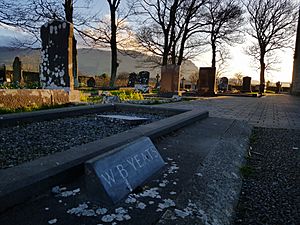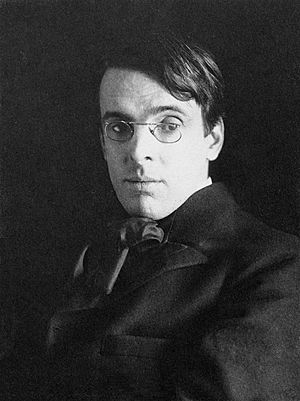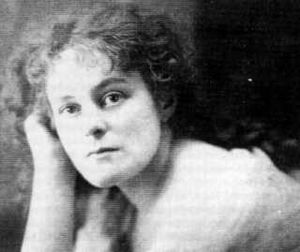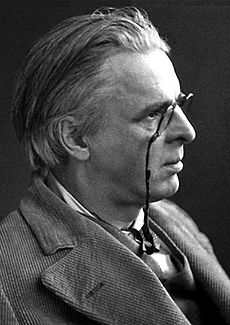W. B. Yeats facts for kids
William Butler Yeats (pronounced YAYTS, rhymes with 'gates') was an Irish poet, writer, and playwright. He was a very important figure in 20th-century literature. Yeats helped start the Irish Literary Revival, a movement that brought Irish literature back to life. He also helped create the famous Abbey Theatre in Dublin. Later in his life, he served as a Senator in the Irish Free State government.
Yeats was born in Sandymount, Ireland, in 1865. His family was Protestant and of Anglo-Irish background. He grew up in Dublin and London, spending holidays in County Sligo. From a young age, he loved poetry. He was especially interested in Irish legends and the occult (mysterious, magical things). These themes appear in his early writings, from his student days until around 1900. His first book of poems came out in 1889. These poems were slow and musical, showing influences from older poets.
After 1900, his poetry became more real and focused on politics. He moved away from some of his earlier mystical beliefs, but still explored ideas about life's cycles. He became the main playwright for the Irish Literary Theatre in 1897. He also supported younger poets like Ezra Pound. In 1923, Yeats won the Nobel Prize in Literature. Some of his important later works include The Tower (1928) and Words for Music Perhaps and Other Poems (1932).
Contents
William Butler Yeats: Early Life and Dreams
Childhood and Family
William Butler Yeats was born in Sandymount, County Dublin, Ireland. His father, John Butler Yeats, was a painter. His mother, Susan Pollexfen, came from a wealthy family in Sligo. Soon after William was born, his family moved to Sligo to live with his mother's relatives. William grew to love Sligo, seeing it as his childhood home. He felt a deep connection to its landscapes and the sea.
The Yeats family was very artistic. William's brother, Jack Butler Yeats, became a famous painter. His sisters, Elizabeth and Susan Mary (Lollie and Lily), were involved in the Arts and Crafts movement.
Yeats grew up in a time when Ireland was changing a lot. His family was part of the Protestant minority who had a lot of power. But in the late 1800s, Irish nationalism grew stronger. This shift affected Yeats deeply and shaped his views for the rest of his life.
School Days and Early Writings
In 1867, Yeats's family moved to England so his father could focus on his art career. At first, William and his siblings learned at home. Their mother told them Irish folktales. Their father taught them geography and chemistry.
In 1877, William started at Godolphin School in London. He wasn't a great student, especially in math and languages. But he loved biology and zoology. In 1880, his family moved back to Dublin for financial reasons. Yeats continued his education at Erasmus Smith High School. He spent a lot of time in his father's art studio, meeting many artists and writers.
Yeats began writing poetry during this time. In 1885, the Dublin University Review published his first poems. He also studied art at the Metropolitan School of Art in Dublin.
Becoming a Writer
Yeats started writing his first poems and plays when he was seventeen. His early works were influenced by poets like Percy Bysshe Shelley. They often had a dreamy, somewhat sad feeling. Soon, he became very interested in Irish mythology and folklore and the writings of William Blake. Yeats admired Blake, calling him one of the "great artificers of God."
In 1891, Yeats published a short novel called John Sherman and a story called "Dhoya." He was also influenced by Oscar Wilde, especially in his ideas about art and plays.
William Butler Yeats: Mysticism and Love
Exploring Mysticism
In 1887, Yeats's family returned to London. He joined a group called the Hermetic Order of the Golden Dawn in 1890. This group studied magic and spiritual ideas. With Ernest Rhys, he also started the Rhymers' Club, where poets met to share their work.
Yeats was interested in mysticism, spiritualism, and astrology throughout his life. He read many books on these topics. He even joined a group that researched the paranormal called "The Ghost Club" in 1911. He believed that his mystical studies were central to all his writing. His interest in these ideas, including Hinduism and the occult, shaped much of his later poetry.
First Poems and Irish Legends
Yeats's first important poem was "The Island of Statues." It was a fantasy story. His first solo publication was a small book called Mosada: A Dramatic Poem (1886).
His collection The Wanderings of Oisin and Other Poems (1889) was very important. The long poem "The Wanderings of Oisin" is based on ancient Irish myths. It took him two years to write. This poem explored a key theme for Yeats: the idea of choosing a life of quiet thought over a life of action. After this, he never wrote another very long poem.
His other early poems, like those in Poems (1895), The Secret Rose (1897), and The Wind Among the Reeds (1899), focused on love or mystical topics.
Maud Gonne: A Lasting Influence
In 1889, Yeats met Maud Gonne. She was a young English woman who strongly supported Irish independence. Yeats became deeply fascinated by her. She had a huge and lasting impact on his poetry and his life. Yeats later said she brought an "over-powering tumult" into his life.
Yeats proposed marriage to Gonne four times between 1891 and 1901, but she always said no. In 1903, she married an Irish nationalist, John MacBride, which upset Yeats greatly. He saw her as his muse, and losing her to another man was difficult.
Yeats had a brief romantic relationship with Olivia Shakespear between 1894 and 1897.
Maud Gonne's marriage to MacBride was not happy. This led her to visit Yeats more often in London. After her son, Seán MacBride, was born in 1904, Gonne and MacBride decided to separate.
William Butler Yeats: Irish Theatre and Nobel Prize
Founding the Abbey Theatre
In 1896, Yeats met Lady Gregory, who encouraged his interest in Irish nationalism and drama. Together with Lady Gregory, Edward Martyn, and other writers like J. M. Synge, Yeats helped create the "Irish Literary Revival" movement. This movement aimed to bring Irish stories and traditions into literature.
In 1899, Yeats, Lady Gregory, and others founded the Irish Literary Theatre. Their goal was to promote Irish plays. They wanted to create a theatre where Irish audiences could enjoy new Irish art. Yeats believed this would allow for new artistic movements.
This group later became the Irish National Theatre Society. With the help of William and Frank Fay, and their secretary Annie Horniman, they opened the Abbey Theatre in Dublin on December 27, 1904. Yeats's play Cathleen ni Houlihan was performed on the opening night. Yeats remained involved with the Abbey Theatre until his death, writing many plays for it.
In 1902, Yeats also helped start the Dun Emer Press (later Cuala Press) to publish works by Irish writers. His sisters ran the press, which published over 70 books, including 48 by Yeats himself.
Working with Ezra Pound
Yeats met the American poet Ezra Pound in 1909. Pound admired Yeats and even worked as his secretary from 1913 to 1916. Pound helped Yeats learn about Japanese Noh plays, which influenced Yeats's own plays.
Yeats was close to Lady Gregory and often visited her home, Coole Park, in County Galway. This place was important for Irish writers and artists. His poem, "The Wild Swans at Coole" was written there.
A Senator for Ireland
Yeats was an Irish nationalist. He wanted to see a strong, independent Ireland. After Ireland gained independence, he was appointed a Senator for the Irish Free State in 1922. He served two terms.
In the 1930s, Yeats was interested in the strong, nationalistic movements happening in Europe. He wrote some marching songs for the Blueshirts, an Irish political group, though they were never used. He was against too much individualism and believed in a strong national identity. He retired from the Senate in 1928 due to poor health.
Marriage and Family
By 1916, Yeats was 51 and wanted to marry and have children. He proposed to Maud Gonne one last time, but she refused. He then proposed to her daughter, Iseult Gonne, but she also said no.
In September 1917, Yeats proposed to 25-year-old Georgie Hyde-Lees, known as George. She accepted, and they married on October 20, 1917. Their marriage was happy despite the age difference. They had two children, Anne and Michael.
Early in their marriage, George and William experimented with "automatic writing." George would write while in a trance, and they believed spirits were communicating complex ideas to them. Yeats used this material to write his book A Vision (1925).
Winning the Nobel Prize
In December 1923, Yeats received the Nobel Prize in Literature. He was honored "for his always inspired poetry, which in a highly artistic form gives expression to the spirit of a whole nation." He knew this award was important for Ireland, which had recently become independent. He said the honor was for Irish literature as a whole.
At his acceptance speech in Sweden, Yeats spoke about Irish nationalism and cultural independence. He said that Irish theatres were empty before they started creating Irish plays. The prize made his books much more popular, and he finally had enough money to pay off his debts and his father's.
Later Years and Passing
Yeats's health improved in 1925. He continued to write a lot, including more for A Vision. He retired from the Senate in 1928 due to his health.
He spent his last years writing many poems, plays, and prose. In 1938, he saw the first performance of his play Purgatory at the Abbey Theatre. His book Autobiographies of William Butler Yeats was also published that year.
William Butler Yeats died in Menton, France, on January 28, 1939, at age 73. He was buried quietly in France. His wish was to be buried there for a year, then moved to Sligo, Ireland. In September 1948, his body was moved to St Columba's Church in Drumcliff, County Sligo. This was done by the Irish Naval Service. Seán MacBride, Maud Gonne's son, helped arrange the move.

His grave has a famous epitaph from his poem "Under Ben Bulben":
Cast a cold Eye
On Life, on Death.
Horseman, pass by!
William Butler Yeats: Poetic Style
Yeats is considered one of the most important English-language poets of the 20th century. He was a Symbolist poet, meaning he used images and symbols to suggest deeper, often timeless, meanings. He chose words carefully to create rich and resonant ideas.
Unlike some modern poets who used free verse (poetry without a regular rhythm or rhyme), Yeats was a master of traditional poetic forms. As he grew older, his language became simpler and more direct. His later poems often discussed his children and the experience of aging. In his poem "The Circus Animals' Desertion", he wrote:
Now that my ladder's gone
I must lie down where all the ladders start
In the foul rag and bone shop of the heart.
Yeats spent his last time at his summer home, Thoor Ballylee, in County Galway, in 1929. He continued to write a lot until his death.
His early poetry was full of Irish myths and folklore. Later, his work focused more on modern issues. His style changed a lot over time. His early poems were very decorative and sometimes formal. He started with long poems like The Isle of Statues. His middle period saw him try a more direct and sometimes harsh style.
In his later work, Yeats found new ideas from his mystical studies, especially from spiritualism. This poetry often returned to themes from his early work, like the difference between a worldly person and a spiritual one.
Many critics see Yeats as a bridge between 19th-century poetry and 20th-century modernism. His poem "The Second Coming" is well-known. His later collections like The Tower (1928) and The Winding Stair (1933) contain some of the most powerful images in 20th-century poetry.
Works
Legacy
Yeats is remembered in Sligo town with a statue created in 1989 by Rowan Gillespie. It stands near the Ulster Bank, which Yeats once said reminded him of the Royal Palace in Stockholm where he received his Nobel Prize. Across the river is the Yeats Memorial Building, home to the Sligo Yeats Society. A sculpture by Henry Moore is in the W. B. Yeats Memorial Garden in St Stephen's Green in Dublin.
There is also a blue plaque dedicated to Yeats at Balscadden House in Howth, where he lived from 1880 to 1883. In London, a plaque marks his former home at 23 Fitzroy Road.
Music Inspired by Yeats
Some composers have created music based on Yeats's poetry. For example, Marcus Paus's choral work The Stolen Child (2009) uses Yeats's poem. It is described as "magically wild" and captures the mystery of Yeats's work.
See also
 In Spanish: William Butler Yeats para niños
In Spanish: William Butler Yeats para niños







